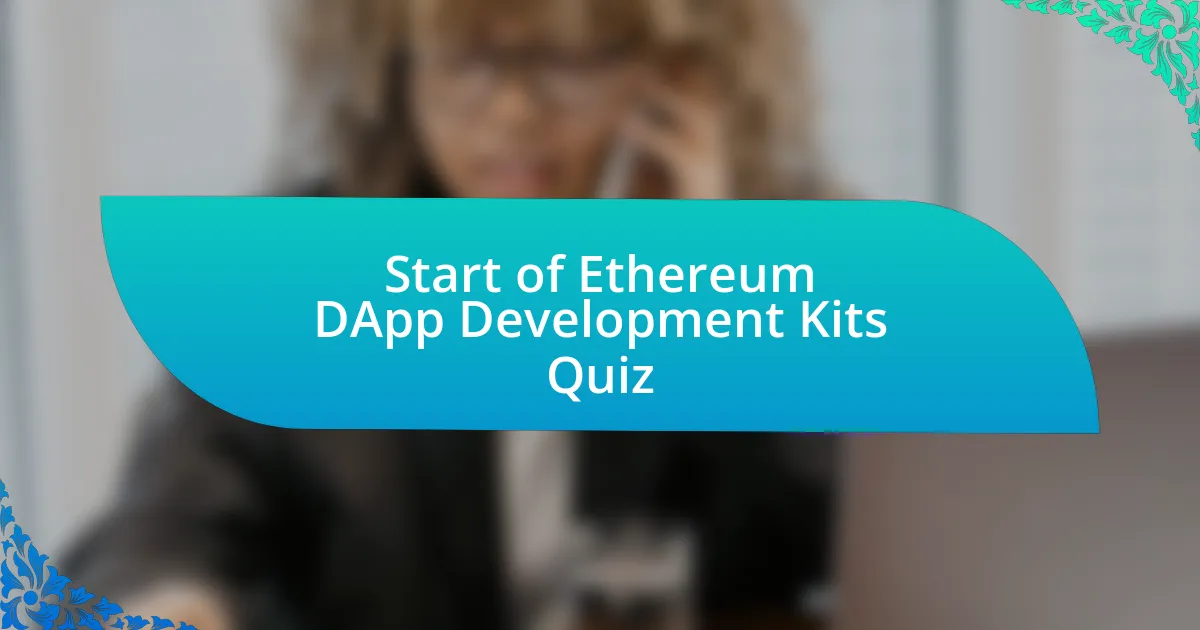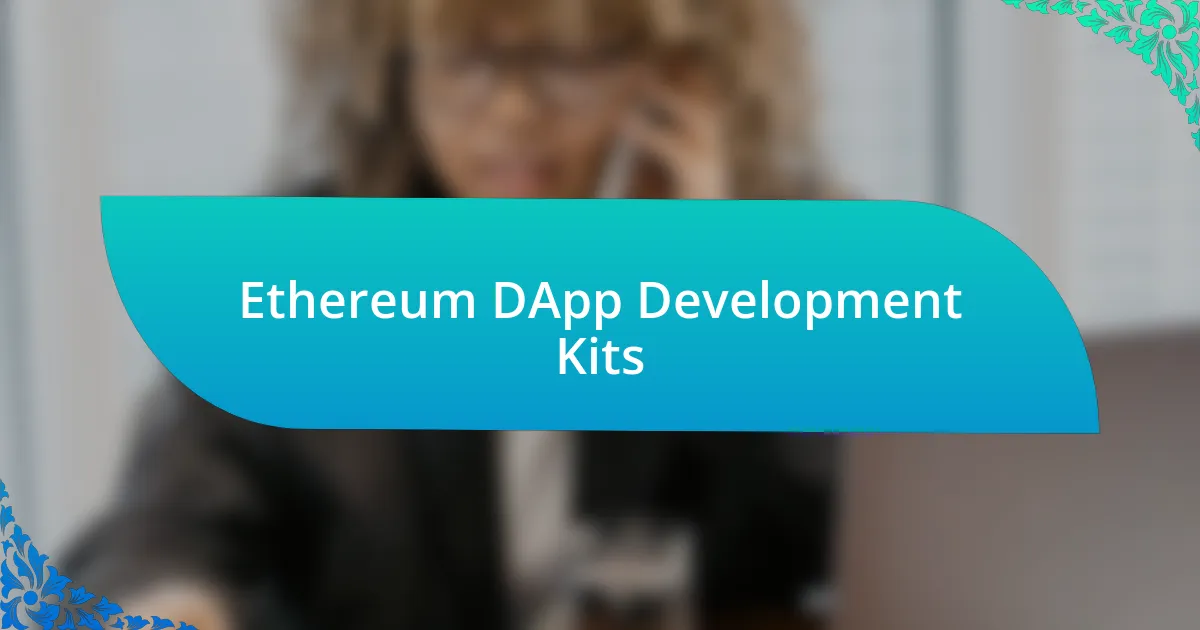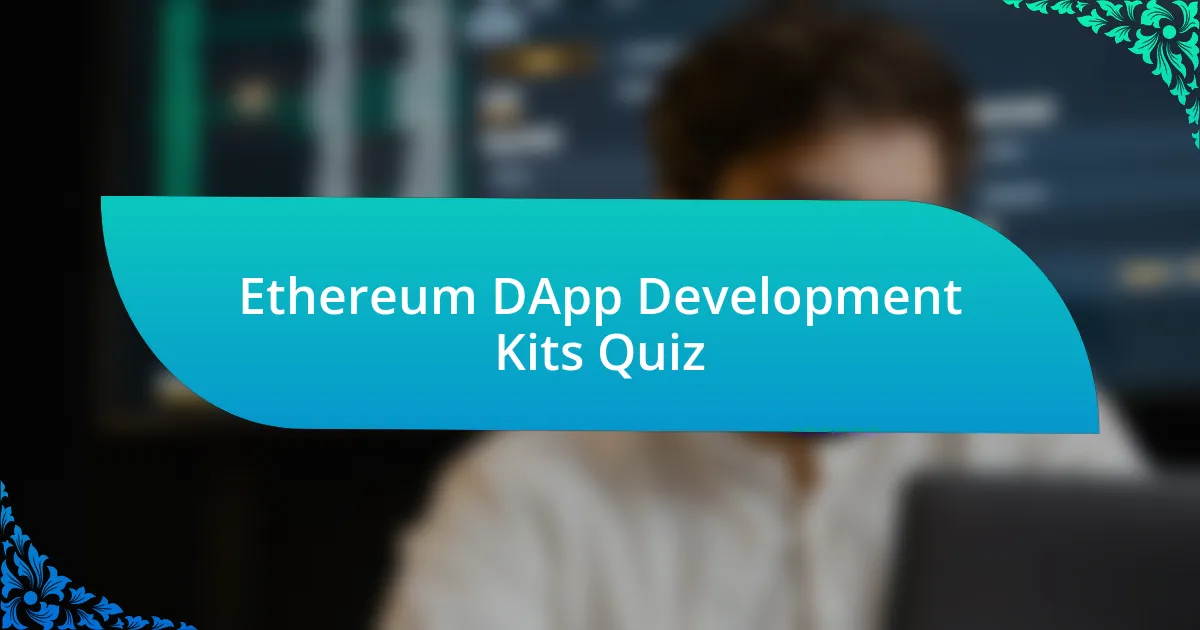
Start of Ethereum DApp Development Kits Quiz
1. What is the primary purpose of Truffle Suite in Ethereum DApp development?
- Truffle Suite is designed solely for cryptocurrency mining.
- Truffle Suite is strictly a trading platform for Ether.
- Truffle Suite primarily focuses on security auditing techniques.
- Truffle Suite is an all-in-one solution for Ethereum DApp development.
2. What is the key feature of Hardhat that allows developers to customize their setup?
- Plugin system
- Automated testing
- Event logging
- Code optimization
3. What does Ethers.js provide for front-end DApp development?
- Advanced analytics for Ethereum gas fees.
- Simplified tools for managing wallets and smart contracts.
- Comprehensive market research for cryptocurrency trends.
- Secure hosting services for DApp deployment.
4. What is the primary advantage of using Ethers.js in DApp development?
- It provides a secure environment for mining cryptocurrencies.
- It allows for complex backend processing of transactions.
- Its lightweight design is optimized for performance and easy integration.
- It specializes in creating visual interfaces for smart contracts.
5. What is the use case for Ethers.js in decentralized exchanges?
- Ethers.js is used for designing centralized exchange interfaces.
- Ethers.js serves as a blockchain mining tool for exchanges.
- Ethers.js manages social media accounts for decentralized exchanges.
- Ethers.js simplifies transaction handling for decentralized exchanges.
6. What does Embark provide for DApp creation?
- Search engine optimization
- Wallet integration tools
- Smart contract management
- Data analysis features
7. What is the use case for Embark in Ethereum DApps with React-based interfaces?
- Embark simplifies the creation of DApps with React-based interfaces.
- Embark is a framework for managing traditional web servers.
- Embark primarily focuses on improving Ethereum consensus algorithms.
- Embark is used for mining cryptocurrencies efficiently.
8. What are the key features of Hardhat’s debugger?
- Hardhat’s debugger prevents all Solidity errors from occurring during development.
- Hardhat’s debugger automatically fixes Solidity errors, ensuring code runs smoothly.
- Hardhat’s debugger highlights and explains errors in Solidity, saving time on diagnosing issues.
- Hardhat’s debugger creates a visual representation of the entire blockchain state.
9. What is the purpose of Hardhat Network in DApp development?
- Hardhat Network enables developers to deploy and test their contracts locally with a feature-rich Ethereum simulator.
- Hardhat Network allows developers to create new blockchains from scratch.
- Hardhat Network provides a marketplace for DApps to be published.
- Hardhat Network is used for managing blockchain consensus algorithms.
10. What is the primary purpose of Truffle Suite in DeFi projects?
- Truffle Suite is widely used in DeFi projects due to its tools for rigorous testing and security.
- Truffle Suite is designed for creating and managing Ethereum token standards.
- Truffle Suite is primarily a wallet for Ethereum transactions.
- Truffle Suite is mainly used for visualizing blockchain data and analytics.
11. What is the difference between Bitcoin and Ethereum blockchain?
- Ethereum is designed exclusively for peer-to-peer transactions like Bitcoin.
- Bitcoin uses a proof-of-stake consensus mechanism for transactions.
- Bitcoin allows for advanced programming and dApps, unlike Ethereum.
- Bitcoin is primarily a digital currency while Ethereum supports smart contracts.
12. What is a decentralized application (dApp)?
- A decentralized application (dApp) is created to take advantage of blockchain technologies, offering benefits like decentralization and open-source protocols.
- A mobile application designed solely for games and entertainment.
- A centralized application that operates on a single server without blockchain features.
- A standard web application hosted on traditional web servers.
13. Where are transactions recorded on the Ethereum blockchain?
- Local storage
- Private database
- Encrypted archive
- Public ledger
14. What are the three types of Ethereum networks?
- Mainnet, Testnet, Private networks
- Testnet, Sidechain, Centralized networks
- Mainnet, Sidechain, Phantom networks
- Ropsten, Matic, Lightning networks
15. How does one mine Ethers?
- You go to an exchange and buy Ether directly with fiat currency.
- You simply download an app that generates Ether for you automatically.
- One needs to have a wallet and tools like Geth CLI to participate in the network and help add transactions to the blocks.
- You collect Ether tokens from your friends in a social network.
16. What is the value token for Ethereum?
- Ripple (XRP)
- Bitcoin (BTC)
- Litecoin (LTC)
- Ether (ETH)
17. What is the programming language used to write smart contracts and dApps?
- JavaScript
- C++
- Solidity
- Python
18. What is MetaMask used for?
- MetaMask is a smart contract development framework for Ethereum.
- MetaMask is a blockchain analytics tool for monitoring transactions.
- MetaMask is a browser-based Ethereum wallet that can be used to interact with dApps on the Ethereum network.
- MetaMask is a decentralized exchange for trading cryptocurrencies.
19. What are the denominations of Ether in order?
- Wei, Finney, Szabo, Ether
- Finney, Gwei, Ether, Wei
- Szabo, Ether, Finney, Gwei
- Ether, Tether, Szabo, Finney
20. What is the purpose of Testnet in Ethereum development?
- Testnet is used exclusively for trading real cryptocurrencies.
- Testnet allows developers to test their smart contracts and dApps without using real Ether.
- Testnet prevents all users from accessing the blockchain.
- Testnet is a permanent version of the Ethereum mainnet.
21. Do you need to use real Ether to test dApps and smart contracts?
- Yes, you must use real Ether for all tests.
- Testing can only be done on the mainnet with real Ether.
- Real Ether is required only for mainnet deployments.
- No, you do not need to use real Ether. Test networks use free Ether.
22. What is the functionality of Remix in Ethereum development?
- Remix is a blockchain protocol for transaction validation in Ethereum development.
- Remix is a hardware wallet used to store Ether and tokens securely.
- Remix is a service for trading Ethereum-based tokens with no coding required.
- Remix is an online IDE for Ethereum that allows developers to write, compile, and deploy smart contracts directly in the browser.
23. What is the difference between spending and modifying a smart contract?
- Modifying does not require any form of gas payment at all.
- Spending does not modify the smart contract and does not incur gas costs.
- Spending always incurs a high cost due to transaction fees.
- Modifying a smart contract is the same as executing a transaction.
24. What is the role of the Ethereum Virtual Machine (EVM) in Ethereum?
- The EVM is responsible for transaction mining in Ethereum.
- The EVM manages user accounts and wallets.
- The EVM stores user data for applications.
- The EVM processes smart contracts on the Ethereum network.
25. What are the benefits of having a private network in Ethereum?
- Private networks ensure that all transactions are public and transparent.
- Private networks eliminate the need for gas fees entirely.
- Private networks increase transaction speeds and scalability.
- Private networks provide data privacy, permissions testing, and better control.
26. What is the block time and average block size in Ethereum?
- The block time is 20 seconds, and the average block size is 500 KB.
- The block time is 14 seconds, and the average block size is 2 KB.
- The block time is 30 seconds, and the average block size is 10 KB.
- The block time is 10 seconds, and the average block size is 1 MB.
27. Can transactions be kept hidden on the public Ethereum network?
- Transactions are only visible to the sender.
- No, all transactions on the public Ethereum network are public.
- Only some transactions can be kept hidden.
- Yes, transactions can be completely hidden.
28. Is the user’s private key used to sign transactions?
- Yes, the user’s private key is used to sign transactions.
- No, the user`s public key is used to sign transactions.
- No, transactions are signed by a third-party service.
- Yes, transactions are signed using the user`s wallet address.
29. What is the purpose of decentralized app distribution in Ethereum frameworks?
- Decentralized app distribution is primarily concerned with marketing decentralized applications to users.
- Decentralized app distribution focuses on creating user interface designs for dApps.
- Decentralized app distribution manages centralized servers for hosting dApps effectively.
- Decentralized app distribution integrates with storage options like IPFS to ensure the smooth deployment and maintenance of dApps.
30. What are the key features of software frameworks in Ethereum dApp development?
- Key features include spinning up a local blockchain instance, utilities for compiling and testing smart contracts, client development add-ons, and configuration to connect to Ethereum networks.
- Key features include the ability to mine Ether, transaction fees calculations, a consensus algorithm for scalability, and managing user profiles.
- Key features include hardware wallet integration, creating traditional web applications, analytics for user behavior, and payment processing frameworks.
- Key features include user authentication, centralized database management, file storage optimization, and mobile application support.

Congratulations! You Have Successfully Completed the Quiz
Well done on finishing the quiz on Ethereum DApp Development Kits! This process allowed you to test your knowledge and identify areas for further learning. We hope you found it both informative and enjoyable. Engaging with the quiz helps reinforce the concepts surrounding decentralized applications, which is crucial in today’s tech-driven world.
Throughout this quiz, you may have discovered essential tools and frameworks that aid in developing Ethereum DApps. Understanding these resources can significantly streamline your development process. Moreover, grasping the nuances of smart contracts and the Ethereum ecosystem is key to becoming a proficient developer in this space.
We invite you to delve deeper into our next section about Ethereum DApp Development Kits. Here, you will find valuable information that expands on the topics covered in the quiz. Enhancing your knowledge will empower you to create better decentralized applications and bring innovative ideas to life. Don’t miss out on this opportunity to further your skills!

Ethereum DApp Development Kits
Overview of Ethereum DApp Development Kits
Ethereum DApp Development Kits are frameworks designed to assist developers in creating decentralized applications (DApps) on the Ethereum blockchain. These kits provide a collection of tools, libraries, and documentation that simplify the development process. They allow developers to build applications that leverage smart contracts and the unique features of the Ethereum network, such as transparency and immutability. By using these kits, developers can focus on coding unique functionalities rather than dealing with the complexities of underlying blockchain technology.
Core Components of Ethereum DApp Development Kits
Core components of Ethereum DApp Development Kits typically include libraries for smart contract development, user interface frameworks, and testing environments. Libraries such as Web3.js enable interaction between DApps and the Ethereum network. User interface frameworks help in building responsive front-end applications. Testing environments, like Truffle or Hardhat, facilitate local testing of smart contracts and DApps, ensuring correctness before deployment on the mainnet. Together, these components streamline the DApp development lifecycle.
Popular Ethereum DApp Development Kits
Popular Ethereum DApp Development Kits include Truffle Suite, Hardhat, and Embark. Truffle Suite offers development and testing tools as well as asset pipelines. Hardhat provides a flexible JavaScript-based environment focusing on smart contract development and testing. Embark is designed for building and deploying DApps with built-in support for decentralized storage and communication. Each kit serves specific developer needs, enhancing productivity and efficiency.
Advantages of Using Ethereum DApp Development Kits
Advantages of using Ethereum DApp Development Kits include increased development speed, ease of testing, and better collaboration. These kits often come with pre-built templates and automated deployment processes, significantly speeding up development time. Built-in testing frameworks allow for efficient debugging and validation of smart contracts. Additionally, these tools enable teams to collaborate seamlessly, as shared libraries and components promote consistency across projects.
Future Trends in Ethereum DApp Development Kits
Future trends in Ethereum DApp Development Kits point towards enhanced interoperability, integration with layer 2 solutions, and improved user experience. Developers are increasingly focusing on creating DApps that can interact with multiple blockchain ecosystems. Integration with layer 2 scaling solutions aims to reduce gas fees and improve transaction speeds. User experience improvements will focus on making DApps more accessible to non-technical users, expanding the reach and adoption of decentralized applications.
What are Ethereum DApp Development Kits?
Ethereum DApp Development Kits are software tools and frameworks that facilitate the development of decentralized applications (DApps) on the Ethereum blockchain. These kits provide developers with libraries, templates, and APIs to streamline the creation and deployment process. Notable examples include Truffle, Hardhat, and OpenZeppelin. They enhance productivity by offering built-in testing, smart contract management, and easy integration with Ethereum networks.
How do Ethereum DApp Development Kits work?
Ethereum DApp Development Kits work by providing a structured environment for developers to build, test, and deploy DApps. They utilize tools and libraries that support smart contract development in languages like Solidity. Through predefined templates and commands, developers can automate tasks such as compiling contracts, running tests, and managing migrations. For example, Truffle includes a command-line interface to easily create and manage projects.
Where can developers find Ethereum DApp Development Kits?
Developers can find Ethereum DApp Development Kits on platforms like GitHub, where many of these tools are open-source. Additionally, official websites of tools like Truffle, Hardhat, and OpenZeppelin offer downloads and documentation. Package managers such as npm also provide easy installation for these kits. This accessibility supports a wide range of developers in the Ethereum ecosystem.
When were Ethereum DApp Development Kits first introduced?
Ethereum DApp Development Kits began to emerge shortly after the launch of the Ethereum network in July 2015. Truffle, one of the first significant development frameworks, was released in 2015. The growth of DApp development tools accelerated in subsequent years, particularly around 2017, coinciding with the boom of Initial Coin Offerings (ICOs) and the growing interest in blockchain technology.
Who are the main users of Ethereum DApp Development Kits?
The main users of Ethereum DApp Development Kits include software developers and blockchain engineers focused on creating decentralized applications. These users range from individual developers and startups to large enterprises seeking to leverage blockchain technology. Familiarity with programming languages, particularly Solidity, is essential for effective use. This diversity highlights the broad appeal and applicability of these tools in the tech industry.

